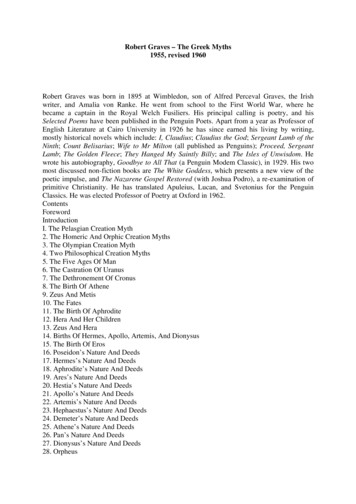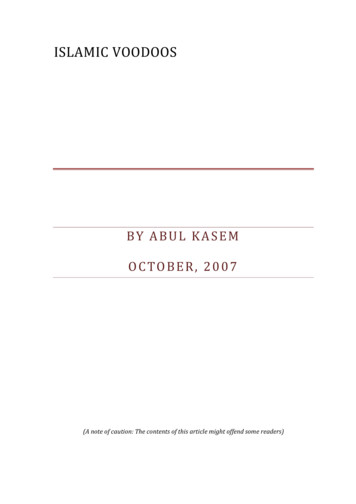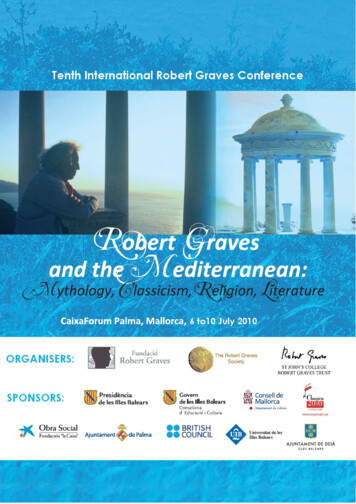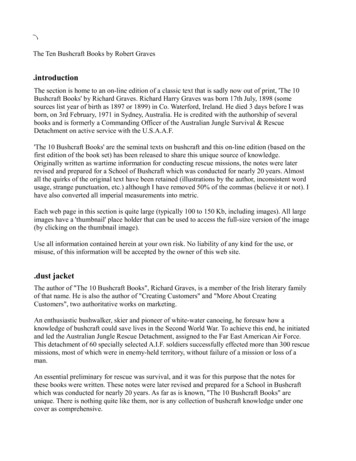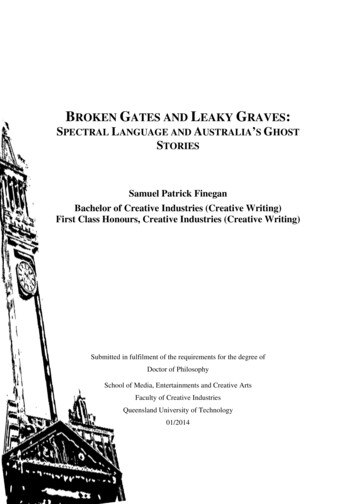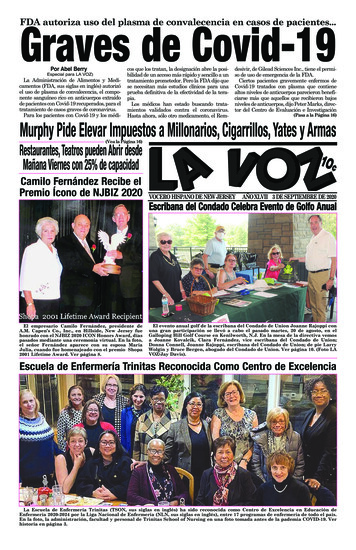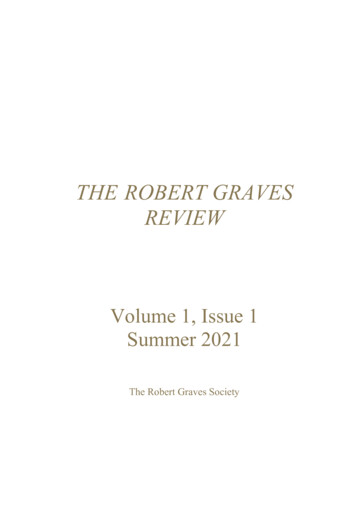
Transcription
THE ROBERT GRAVESREVIEWVolume 1, Issue 1Summer 2021The Robert Graves Society
Editor: Michael Joseph (USA)Associate Editors: Alicja Bemben (Poland), Lucia Graves (UK), PatrickVilla (UK)Bibliography Editor: Carl Hahn (USA)Associate Poetry Editors: Fran Brearton (Northern Ireland), DunstanWard (France)Editorial Board: Fran Brearton (Northern Ireland), Robert Davis(Scotland), Carl Hahn (USA), Michael Irwin (UK), Anett Jessop (USA),John Kelly (UK), Alice Hughes Kersnowski (USA), Frank Kersnowski(USA), Grevel Lindop (UK), Patrick McGuinness (UK), CharlesMundye (UK), Chris Nicholson (UK), Paul O’Prey (UK), JohnWoodrow Presley (USA), Juana María Seguí Aznar (Spain)Production and DTP: Michael JosephThis publication is financed by the Robert Graves Society. Its primaryreferential version is the electronic one.Online ISSN: 2635-0904Print ISSN: 2635-0890Postal address:St. John’s CollegeSt. GilesOxfordOX1 3JPContact information:Michael Josephmjoseph@rutgers.eduAttribution-ShareAlike 4.0 International (CC BY-SA 4.0)Covert art – Robert Graves beside olive tree in Deyá, 1969, photographby Lloyd Borguss (1928-2017). Original photograph in the University ofVictoria Library Special Collections, Robert Graves Collection, SC050.
CONTENTSEditor’s IntroductionMichael Joseph .iCRITICAL STUDIES \The ‘Reserve of Superstition’: Graves, Coleridge,and the Poetry of MysteryGregory Leadbetter . 3What Handwashing and Social Distancing in the Times of CoronaRemind Us: The Left Hand is as Vital as the RightDevindra Kohli . 17William Nicholson and The Pirate TwinsMarilynn S. Olson . 27Robert Graves’s Favourite Poem? The One that Saved his LifePaul O’Prey . 53Drawing Music from Penny Fiddles, or, a Biographical Accountof Robert Graves and Theodore Roethke’s Secret Lives asChildren’s Poets with a Look at their Neglected Masterworks,The Penny Fiddle and I Am! Says the Lamb, along with a FewOther Things’Joseph T. Thomas, Jr. . 61Never-Begotten Perfect Daughters: Laura Riding’s and Mina Loy’sSteinian InheritancesEva Isherwood-Wallace . 83The Claudian Dilogy and its Early CriticismAlicja Bemben . 101A Different Look for ‘The Face in the Mirror’Michael Joseph . 115
BIBLIOGRAPHY \The Plague of Modern Scholarship (Theses and Dissertations onthe Subject of Robert Graves)Carl Hahn . 163The Ur-Text to ‘The Country Dance’: An Unrecorded PoemCarl Hahn and Michael Joseph . 195NOTES \Robert Graves Trusts and RelatedWilliam Graves, MBE . 203Atlantis, Lake Tritonis and PharosOliver D. Smith . 215POEMS \Michael LongleyDartford Warbler . 221Plovers . 222Ruth FainlightShe Be Me . 223Grevel LindopFarewell . 225Scrimshaw . 226Witch Bottle . 227Paul O’PreyThe Grieving Saint. 228The Night-Cocklers . 229
Linda Morales CaballeroPas De Deux . 231So Much . 232Visit . 233Sean O’BrienFlying the Flag . 234Star of Bethlehem . 236Poets in this Issue . 237
IntroductionMichael JosephAs many of you are aware, The Robert Graves Society has beenpublishing a journal since 1996. Gravesiana: The Journal of TheRobert Graves Society, an offspring of the two centenaryconferences held in Palma and Oxford, continued a run of journalsabout Robert Graves that began during his lifetime, in 1972. TheRobert Graves Review succeeds Gravesiana.Retiring Gravesiana was a gradual process begun in 2016 whenCharles Mundye, then incoming Society President, suggested anew title that more clearly asserted the journal’s identity as avehicle for contemporary scholarship would better fit our purpose.Wanting to avert potential reference problems, we chose first tocomplete Gravesiana volume 4, begun under Dunstan Ward’seditorship in 2014. After publishing the last issue in summer 2020,the Society pondered name alternatives at a virtual meeting thefollowing December. The Robert Graves Review was suggested,warmly received and after some reflection and prayer, ratified: thename change was announced in February.In addition to the journal’s name, we have renovated ourdelivery system. While we continue to deliver the journal asindividual downloadable essays in PDF format, we are nowoffering under an open access policy texts readable by webbrowsers, the main feature of our new website, engineered byPhilip Graves. The new website, part of a larger Society websiteinitiative described below in William Graves’s ‘Robert GravesTrusts and Related’, will make submitting and reviewing texts forpublication easier, and give readers quicker access to moreinformation about the journal; and it will enable us to respondbetter to changing technologies and enhancements. We would liketo extend to Philip our heartfelt gratitude for generously donatinghis wizardly skills to our enterprise. As well as an education, it has
iiMichael Josephbeen a great pleasure for us working with him over the last fivemonths and watching a premier website take shape under hishands.Readers will notice that we have also expanded our editorialstaff and board. Alicja Bemben, a literature scholar at theUniversity of Silesia has joined our cohort of Associate Editors,Lucia Graves and Patrick J. Villa. Carl Hahn, a Gravesbibliographer, has become Bibliography Editor, and formerSociety presidents Fran Brearton and Dunstan Ward have assumedthe title and toil of Associate Poetry Editors. Their contributionswill be immediately evident to everyone reading this issue and theissues to come. The Board has also grown, adding Anett Jessop, aModernist scholar based at the University of Texas at Tyler, andone of our two North American Vice Presidents. It is our pleasureto introduce them and welcome them to The Robert GravesReview.The Robert Graves Review 1.1, unfolds in four sections, CriticalStudies, Bibliography, Notes, and Poems. Critical Studies beginswith Gregory Leadbetter’s ‘The “Reserve of Superstition”:Graves, Coleridge, and the Poetry of Mystery’, which presents anew coinage, reviving an old coinage from by S. T. Coleridgeriffing on a phrase from Sir Walter Scott. The ‘reserve ofsuperstition’ is a ‘supra-cognitive sensitivity’, a kind of modalityof conscious or mental state Leadbetter describes as essential toboth spirituality and poetic creativity, one that allies Coleridge andGraves in the ‘revision of spirituality’. In his ontologicalargument, Leadbetter evokes ‘superstition’ as an active principleoperating in the composition of poetry and tops off his discussionwith his own poem ‘A Poppet’ to demonstrate the modality inpraxis.Nodding toward our obsessive and surely life-saving pandemicroutine, Devindra Kohli looks at hands and handwashing in ‘WhatHandwashing and Social Distancing in the Times of CoronaRemind Us: The Left Hand is as Vital as the Right’. Weavingautobiography into an engaging tour of hand / washing routines in
Introductioniiithe work of various writers, including John Donne, W. B. Yeats,Thomas Hardy, Ernst Jandle, and Robert Graves, Kohli’sdeceptively breezy essay maintains an underlying seriousness andcompassion. He tells us:At the heart of the perceived or mythologized dialectic ofthe hands, then, lies a recognition of a quintessential dualitywithin and without us. It propels our search for balancing orreconciling, however momentarily, through a creativeinteraction with the other within us and without – in thehuman world, in Nature, and the divine. (p. 23)Deceptively breezy might also describe William Nicholson’schildren’s book The Pirate Twins, which Marilyn S. Olsondiscusses in ‘William Nicholson and The Pirate Twins’. As wellas noting personal relationships, such as Robert Graves’sassociation with the precursor dolls Nancy Nicholson fabricatedduring their marriage, and the significance of Jenny Nicholson andEliza Banks to the book’s creation, her beautifully illustratedessay documents its aesthetic and cultural dimensions, thesignificance of the book to the history of children’s literature andto understanding Nicholson’s artistic vision. In what may becomeher essay’s most discussed passage, Olson reads the problematicBlackness of the twin pirates, and its ramifications.Focus shifts from dolls to trolls in Paul O’Prey’s bio-criticalanalysis of ‘The Troll’s Nosegay’, a whimsical sonnet Gravescomposed in 1919 depicting a troll charged by ‘a lady’ to provideher a nosegay – a small bouquet. Graves light-heartedly transposesthe paradigmatic comic lovers into a fairy-tale setting to create agossamer sonnet, at a time when his very life hung by a thread.My temperature rose to 105, and both lungs were affected.The over-worked doctor said I had no chance, the householdwept openly, but one thing kept me alive: the obstinateintention of getting my poem right. (p. 59)
ivMichael JosephO’Prey allows space for the reader to consider that soldiers are themost pragmatic of people. War makes one ruthlessly pragmatic.Good soldiering presupposes staying alive, and yet here is Graves,an experienced and by every account a very good soldier, fullyconvinced that composing a fairy tale sonnet would keep himalive. Well, but it did. And this belief epitomises a mode ofmagical thinking that engenders a magical poem.Joseph T. Thomas Jr.’s contribution broadens a critical review ofostensibly simple poems from this early period. He considers theaesthetic complexity of Graves’s poems for children (declaringthem ‘neglected masterworks’) by likening them to children’spoems by Theodore Roethke, Graves’s American contemporary.Thomas’s (take a deep breath, o, clarinettist) ‘Drawing Musicfrom Penny Fiddles, or, a Biographical Account of Robert Gravesand Theodore Roethke’s Secret Lives as Children’s Poets with aLook at their Neglected Masterworks, The Penny Fiddle and IAm! Says the Lamb, along with a Few Other Things’ situates bothpoets in the Romantic tradition of Williams Blake and Yeats, and,provides rich analyses of comparable bearish traits, life and deathconcerns, and what Thomas calls ‘joyous foolery’:Again, this is joyous foolery and nonsense. Like Graves andRoethke, however, I mean it seriously. Like Allie, Ifashioned this essay as a call, as an occasion to summonRoethke and Graves from their rest, to place them on a nicebeach in Mallorca and watch them ‘play by the water’s edge Till the April sun set’, to imagine what we might hearshould we listen in on them as they (like the Boy and thebush) Talk and they Talk and they Talk. (pp. 75-76)One might append to Thomas’s melancholy-playful conclusion aparaphrase from Roethke: ‘and they know they know they know’.In a comparable comparative analysis, Eva Isherwood-Wallacebrings together two first generation Modernists, Laura (Riding)Jackson and Mina Loy, to study their indebtedness to GertrudeStein (whom Graves and Riding published in Seizin Two [1929]).
IntroductionvThe bridge from Thomas’s Postmodernist readings to IsherwoodWallace’s Modernism – and perhaps from Graves’s poetry of thelate teens and twenties to that of the thirties – is nonsense, albeitnonsense of very different strains. In her incisive commentary onshared linguistic properties, Isherwood-Wallace notes the purposeof Steinian nonsense (or, as she prefers ‘non-sense’) was to dehistoricise language.Riding and Loy both identified this sense of ‘pure’ languagein Stein, regarding her often non-sensical poetry as resistantto traditional associations and grammatical form. Their ownpoetry responds to Stein’s approaches, grappling with this‘new’ and ‘pure’ language as a tool against the legacy ofhistorical influence. (p. 85)By the way, Isherwood-Wallace is a grad student at QueensUniversity Belfast, and we are glad to publish the first fruits ofwhat we trust will be a long, productive literary career.Since Isherwood-Wallace’s analysis spins around critical as wellpoetic expression, it seems apt to follow the thread with AlicjaBemben’s meta-critical review of the early critical responses(1956-1999) to Graves’s I Claudius, and Claudius the God. In heressay, Bemben demonstrates that early criticism of the Claudiusbooks collected into three pockets of interest, or, to use hermetaphor, contributed to three ‘pillars’: Graves’s syntheticpredilections (merging opposites, e.g., past and present, fictionand history); the structure of his works; and interpretations of thecentral character, Claudius. Despite the homologous tendenciesshe illuminates, Bemben praises the criticism she surveys forpersistently formulating new perspectives.My essay on Graves’s ‘The Face in the Mirror’ follows, cappingthe Critical Studies section of the journal. In ‘A Different Lookfor “The Face in the Mirror”’, I propose that far from brutallyleveraging the demands of the flesh as incentive for writingpoems, Graves plays off the poem’s focus on materiality tointerrogate the validity of his lifelong claim of being a poet. I also
viMichael Josephtry to show that this poem’s preoccupation with the body(distanced, as is ‘the face’) parallels the poet’s preoccupation withthe terror of history, personal or otherwise, which it attempts toresolve by reimagining the body as (borrowing from Blakecriticism) a ‘body of the imagination’. I end by asking readers toconsider that ‘The Face in the Mirror’ apostrophises the ‘body ofimagination’ in its very form by assuming the contours of thefemale organ of generation.Bibliography contains two pieces, chiefly by Carl Hahn, thejournal’s Bibliography Editor. First, ‘The Plague of ModernScholarship (Theses and Dissertations on the Subject of RobertGraves)’ is a comprehensive list of recorded scholastic worksproduced between 1933 and 2021, along with the referencesources in which these are catalogued. This unique bibliographicresource will serve Graves scholarship for years to come, but thereare also intriguing patterns in the data worthy of pondering in theirown right. For instance, we see the geographical breadth ofGraves scholastic study: thirty-two countries are represented, andsixty-eight American colleges and universities located in thirtyeight states. As well as the familiar pairings with Sassoon,Blunden, Owen, and Hughes, we find Graves rubbing unlikelyelbows with Edith Sitwell, H. Read, Thomas Pynchon, JohnOxenham, Samuel Barber . . . Society members will be pleased,though hardly surprised, to discover the number of scholasticworks on Graves is on the uptick: the period between 1990-1999produced twenty works; that between 2000-2009 produced thirtyfive; and between 2010-2021, fifty-three. The accelerating pace of‘the plague’ means that by the time you are reading these words,the list will be incomplete: but thus, a foundation for futureinstalments.Hahn’s other contribution shares an unrecorded poem publishedin 1926, along with the picture by Stanley North it was written toaccompany. As well as reprinting the lost (untitled) poem, in ‘TheUr-Text to “The Country Dance”’, Hahn and I point out tellingsimilarities between it and the poem it was revised into andthematic links with ‘The White Goddess’.
IntroductionviiBalancing the deep verticality of Hahn’s dive into dissertations,William Graves MBE begins the Notes section with an expansivebird’s-eye view of what might be called the functioning Gravesuniverse. In tracing his ‘efforts over more than thirty-five years topreserve and make accessible for research and general knowledgethe writings of [his] father’, William illuminates the achievementsof The Robert Graves Copyright Trust, St John’s College RobertGraves Trust, The Fundació Robert Graves, and other initiativesthat directly or indirectly inform the studies of every writerpresent in our journal and many of its readers, too. William alsorehearses a thumbnail history of the journal, and thus here seemsan opportune moment to acknowledge that The Robert GravesReview owes William Graves a profound debt of gratitude forsupporting the website on which you may be reading this sentenceoffering him our humble thanks for his vision, resolve, and aweinspiring energy (and did I mention his son, Philip?).Oliver D. Smith concludes Notes by marking Graves’s writingsduring the nineteen fifties and sixties on the legend of Atlantis,which challenged the conventional wisdom by asserting a factualbasis for Plato’s account. According to Graves, the legend hadhistorical underpinnings in the flood that washed over the islandof Tritonis, and observations of a sunken harbour at Pharos datingback to the Egyptian New Kingdom. One of the several sources ofSmith’s investigation, ‘The Lost Atlantis’ appears in The CraneBag (1969), which, by chance, also contains ‘The Uses ofSuperstition’, the essay Gregory Leadbetter builds on in thisvolume’s lead-off spot.The Crane Bag, with its freight of essays on mystery, magic,song and poetry, appeared the same year Donovan’s song Atlantishit the charts (even reaching no. 1 in Switzerland). We say this topoint out that, even at seventy-five, having lived most of theprevious forty years in Deyá, Graves was somehow still in touchwith the counterculture of his day.To launch The Review in style, we thought we should respond toIan Firla’s wish, expressed in his introduction to the 1998 issue ofGravesiana, that the journal include more ‘creative writing’, and
viiiMichael Josephthat his own generous selection of poetry wouldn’t be a ‘one-off’.In our no less generous selection, we have included poets whoparticipated in our recent conferences (as did Firla), along withone or two poets we hope you will agree we should know better.Joining company with Gregory Leadbetter’s exemplary poem,introduced in essay number one, are poems by (in order ofappearance) Michael Longley, Ruth Fainlight, Grevel Lindop,Paul O’Prey, and Linda Morales Caballeros. In ways consonantwith William Graves’s magisterial view, we think these poemsilluminate the cutting edge of Graves’s poetic universe.At a moment of weakness, prompted by the references to TheCrane Bag, and the rich gallimaufry of scholarly interests,approaches, styles, and modes of expression, analytical,bibliographic and creative, we have here, we fleetingly considerednaming this issue ‘The Crane Bag’, which would have had theadditional virtue of extending the medley of themed editions thatconcluded Gravesiana. However, enticing though that prospectwas, we decided in the end The Robert Graves Review lostnothing by having no modifying rubric, by appearing just as TheRobert Graves Review volume 1, issue 1.
CRITICAL STUDIES
Robert Graves Society, an offspring of the two centenary conferences held in Palma and Oxford, continued a run of journals about Robert Graves that began during his lifetime, in 1972. The Robert Graves Review succeeds Gravesiana. Retiring Gravesiana was a gradual process begun in 2016 when Charles Mundye, then incoming Society President .


